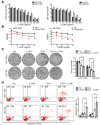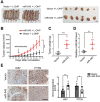Dichloroacetate Overcomes Oxaliplatin Chemoresistance in Colorectal Cancer through the miR-543/PTEN/Akt/mTOR Pathway
- PMID: 31762813
- PMCID: PMC6856576
- DOI: 10.7150/jca.34650
Dichloroacetate Overcomes Oxaliplatin Chemoresistance in Colorectal Cancer through the miR-543/PTEN/Akt/mTOR Pathway
Abstract
Chemoresistance is responsible for most colorectal cancer (CRC) related deaths. In this study, we found that dichloroacetate (DCA), a pyruvate dehydrogenase kinase (PDK) inhibitor, can be used as a sensitizer for oxaliplatin (L-OHP) chemoresistant CRC cells. The aim of this study was to explore the ability of DCA to overcome L-OHP resistance in CRC cells and to identify the underlying molecular mechanisms. We found that DCA sensitizes chemoresistant CRC cells to L-OHP-induced cytotoxic effects by inhibiting clone formation capacity and promoting cell apoptosis. A microRNA (miRNA) array was used for screen, and miR-543 was identified and shown to be downregulated after DCA treatment. The expression of miR-543 was higher in chemoresistant CRC cells than in chemosensitive CRC cells. Overexpression of miR-543 increased chemoresistance in CRC cells. The validated target gene, PTEN, was negatively regulated by miR-543 both in vitro and in vivo, and PTEN was upregulated by DCA through miR-543. In addition, overexpression of miR-543 reversed the inhibition of colony formation after DCA treatment. Furthermore, the Akt/mTOR pathway is activated by miR-543 and is involved in the miR-543 induced chemoresistance. There was a significant inverse relationship between miR-543 expression and PTEN level in CRC patients, and high miR-543 expression was associated with worse prognosis. In conclusion, DCA restored chemosensitivity through miR-543/PTEN/Akt/mTOR pathway, and miR-543 may be a potential marker or therapeutic target for chemoresistance in CRC.
Keywords: chemoresistance; colorectal cancer; miR-543; miR-543 colorectal cancer; oxaliplatin.
© The author(s).
Conflict of interest statement
Competing Interests: The authors have declared that no competing interest exists.
Figures






Similar articles
-
MiR-107 confers chemoresistance to colorectal cancer by targeting calcium-binding protein 39.Br J Cancer. 2020 Mar;122(5):705-714. doi: 10.1038/s41416-019-0703-3. Epub 2020 Jan 10. Br J Cancer. 2020. PMID: 31919406 Free PMC article.
-
Dichloroacetate restores colorectal cancer chemosensitivity through the p53/miR-149-3p/PDK2-mediated glucose metabolic pathway.Oncogene. 2020 Jan;39(2):469-485. doi: 10.1038/s41388-019-1035-8. Epub 2019 Oct 9. Oncogene. 2020. PMID: 31597953 Free PMC article.
-
The Plasma microRNA miR-1914* and -1915 Suppresses Chemoresistant in Colorectal Cancer Patients by Down-regulating NFIX.Curr Mol Med. 2016;16(1):70-82. doi: 10.2174/1566524016666151222144656. Curr Mol Med. 2016. PMID: 26695693
-
Role of microRNAs in the resistance of colorectal cancer to chemoradiotherapy.Mol Clin Oncol. 2018 Apr;8(4):523-527. doi: 10.3892/mco.2018.1578. Epub 2018 Feb 20. Mol Clin Oncol. 2018. PMID: 29556386 Free PMC article. Review.
-
Narrative review of the influence of diabetes mellitus and hyperglycemia on colorectal cancer risk and oncological outcomes.Transl Oncol. 2021 Jul;14(7):101089. doi: 10.1016/j.tranon.2021.101089. Epub 2021 Apr 7. Transl Oncol. 2021. PMID: 33838541 Free PMC article. Review.
Cited by
-
MicroRNA-nanoparticles against cancer: Opportunities and challenges for personalized medicine.Mol Ther Nucleic Acids. 2023 Apr 4;32:371-384. doi: 10.1016/j.omtn.2023.03.021. eCollection 2023 Jun 13. Mol Ther Nucleic Acids. 2023. PMID: 37128277 Free PMC article. Review.
-
The effect of miRNA and autophagy on colorectal cancer.Cell Prolif. 2020 Oct;53(10):e12900. doi: 10.1111/cpr.12900. Epub 2020 Sep 10. Cell Prolif. 2020. PMID: 32914514 Free PMC article. Review.
-
Dichloroacetate for Cancer Treatment: Some Facts and Many Doubts.Pharmaceuticals (Basel). 2024 Jun 6;17(6):744. doi: 10.3390/ph17060744. Pharmaceuticals (Basel). 2024. PMID: 38931411 Free PMC article. Review.
-
Cross-talk between non-coding RNAs and PI3K/AKT/mTOR pathway in colorectal cancer.Mol Biol Rep. 2021 May;48(5):4797-4811. doi: 10.1007/s11033-021-06458-y. Epub 2021 May 31. Mol Biol Rep. 2021. PMID: 34057685 Review.
-
Rewiring glucose metabolism improves 5-FU efficacy in p53-deficient/KRASG12D glycolytic colorectal tumors.Commun Biol. 2022 Oct 31;5(1):1159. doi: 10.1038/s42003-022-04055-8. Commun Biol. 2022. PMID: 36316440 Free PMC article.
References
-
- Chen W, Zheng R, Baade PD, Zhang S, Zeng H, Bray F. et al. Cancer statistics in China, 2015. CA: a cancer journal for clinicians. 2016;66:115–32. - PubMed
-
- Siegel RL, Miller KD, Jemal A. Cancer statistics, 2018. CA: a cancer journal for clinicians. 2018;68:7–30. - PubMed
-
- Miller KD, Siegel RL, Lin CC, Mariotto AB, Kramer JL, Rowland JH. et al. Cancer treatment and survivorship statistics, 2016. CA: a cancer journal for clinicians. 2016;66:271–89. - PubMed
LinkOut - more resources
Full Text Sources
Research Materials
Miscellaneous

